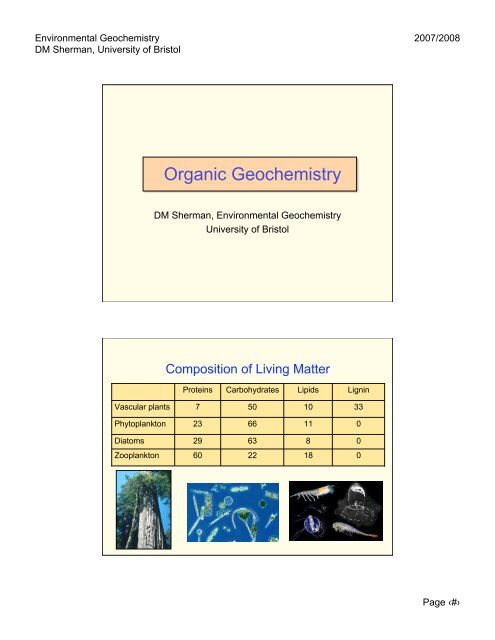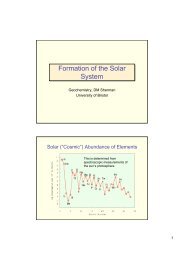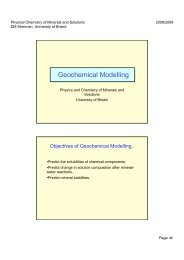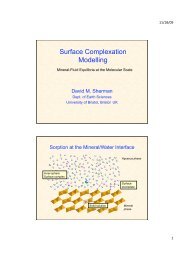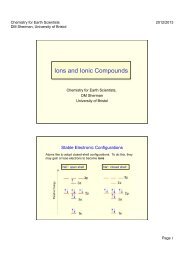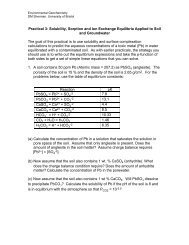Lecture Notes (PDF) - Aqueous and Environmental Geochemistry
Lecture Notes (PDF) - Aqueous and Environmental Geochemistry
Lecture Notes (PDF) - Aqueous and Environmental Geochemistry
You also want an ePaper? Increase the reach of your titles
YUMPU automatically turns print PDFs into web optimized ePapers that Google loves.
<strong>Environmental</strong> <strong>Geochemistry</strong>DM Sherman, University of Bristol2007/2008Molecular Components of BiomassLipidsCarbohydrates <strong>and</strong> PolysaccharidesMolecular Components of BiomassLigninPage ‹#›
<strong>Environmental</strong> <strong>Geochemistry</strong>DM Sherman, University of Bristol2007/2008Hydrolysis Products of BiomassFatty Acids (Hydrophyllic Acids)SugarsAmino AcidsBiological Breakdown of BiomoleculesHydrolysisAmino AcidsFatty AcidsSugarsHumic/Fulvic AcidsRespiration CO 2ProteinsLipidsCarbohydratesLigninFermentationAcetateAlcoholsExtremely anaerobicconditionsMethanogenesis CH 4Page ‹#›
<strong>Environmental</strong> <strong>Geochemistry</strong>DM Sherman, University of Bristol2007/2008Abiotic Breakdown Products of BiomassFulvic AcidsAbiotic Breakdown Products of BiomassHumic AcidPage ‹#›
<strong>Environmental</strong> <strong>Geochemistry</strong>DM Sherman, University of Bristol2007/2008Complexation of Metals by Humic/FulvicAcidsSome metals (Cu, Hg) arecomplexed by HA <strong>and</strong> FA.This may play a role in oreformingprocesses.Organic Carbon in Terrestrial AquaticsystemsPage ‹#›
<strong>Environmental</strong> <strong>Geochemistry</strong>DM Sherman, University of Bristol2007/2008Nature of Humic/Fulvic Acids <strong>and</strong> Humin•Major form of organic matter in soils <strong>and</strong> freshwater.•Origins are still not fully understood but mainhypothesis is that humic/fulvic acids are derived fromthe breakdown of lignin.•Humic Acid = soluble at high pH only•Fulvic Acid = soluble over all pH values•Humin = not soluble at any pHOrganic Carbon in Aquatic systemsPage ‹#›
<strong>Environmental</strong> <strong>Geochemistry</strong>DM Sherman, University of Bristol2007/2008Organic Carbon in Sediments•Sediments contain < 1% organic C.•Nearly all DOC <strong>and</strong> POC in the water column isoxidized by respiration.•For organic C to accumulate in sediments, the flux ofPOC must be high <strong>and</strong> the redox conditions must beanaerobic.Diagenesis <strong>and</strong> Kerogen Formation•Hydrolysis of complex organics•Functional groups are removed.•Double bonds are hydrogenated to give saturatedhydrocarbons•Aromatic compounds increase relative to aliphatic•Condensation of molecular fragments to complexmacromolecules•End product is kerogen a mixture of complex organiccompounds that dominate organic matter in sediments.Page ‹#›
<strong>Environmental</strong> <strong>Geochemistry</strong>DM Sherman, University of Bristol2007/2008Catagenesis of Kerogen to Oil <strong>and</strong> GasDiagenesis: methanogensproduce methane. Organicmatter converted to kerogen.Catagenesis: breakdownof kerogenMetagenesis: breakdownof oil into gas + graphiteMethane HydratesAt the pressures <strong>and</strong> temperaturesof the ocean bottom, biogenicmethane is trapped as clathrates.Page ‹#›
<strong>Environmental</strong> <strong>Geochemistry</strong>DM Sherman, University of Bristol2007/2008Methane HydratesThe stability field ofmethane hydrates islimited to shallow sedimentdepths.Methane is an extremelypotent greenhouse gas<strong>and</strong> release fromsediments could greatlyaccelerate globalwarming.Carbon Isotopic FractionationPage ‹#›
<strong>Environmental</strong> <strong>Geochemistry</strong>DM Sherman, University of Bristol2007/2008Carbon Isotopic FractionationPollution by Organic CompoundsPage ‹#›
<strong>Environmental</strong> <strong>Geochemistry</strong>DM Sherman, University of Bristol2007/2008Organic Pollutants: BTEX CompoundsBiodegradation of Organics (Cont.)C 6 H 6 + 7.5 O 2 → 6CO 2 + 3H 2 OC 6 H 6 + 15MnO 2 + 30H + → 6CO 2 + 18H 2 O + 15Mn 2+C 6 H 6 + 6NO 3-+ H + → 6CO 2 + 3N 2 +6H 2 OC 6 H 6 + 30 FeOOH + 60 H + → 6CO 2 + 48 H 2 O + 30Fe 2+C 6 H 6 + 3.75SO 42-+ 7.5H + → 6CO 2 + 3.75H 2 S + 3H 2 ODecreasing EhC 6 H 6 + 4.5H 2 O → 2.25CO 2 + 3.75CH 4Page ‹#›
<strong>Environmental</strong> <strong>Geochemistry</strong>DM Sherman, University of Bristol2007/2008Spatial Distribution of electron acceptors afterbiodegradation progresses in soilPAH (Polycyclic Aromatic Hydrocarbons)in CreosoteOHOHphenolCH 3cresolnapthaleneBenzo-[a]-pyreneanthraceneCreosote is a common wood preservative butis now banned because it contains PAHs(carcinogenic). These are slow to degrade insoil.Page ‹#›
<strong>Environmental</strong> <strong>Geochemistry</strong>DM Sherman, University of Bristol2007/2008Synthetic ChlorohydrocarbonsOrganohalide Breakdown byMethanogens(1) CCl 2 =CCl 2 (PCE) + H 2 → CCl 2 =CClH (TCE)+ HCl(2) CCl 2 =CClH (TCE) + H 2 → CCl 2 =CH 2 (DCE) + HCl(3) CCl 2 =CH 2 (DCE) + H 2 → CH 2 =CHCl (VC) + HClBreakdown of vinyl chloride (CH 2 =CHCl) requiresaerobic conditions:CH 2 =CHCl (VC) + 5/2O 2 → 2CO 2 + H 2 O + HClPage ‹#›
<strong>Environmental</strong> <strong>Geochemistry</strong>DM Sherman, University of Bristol2007/2008Summary: Abiotic Breakdown ofBiomoleculesLignin, Carbohydrates, Proteins, LipidsFulvic, Humic acids, HuminKerogenHydrocarbonsMethaneGraphitePage ‹#›


